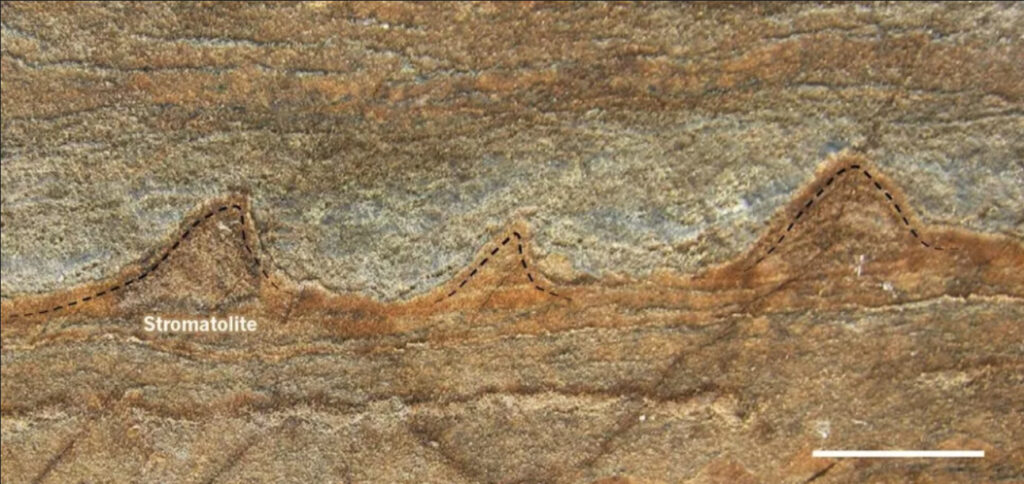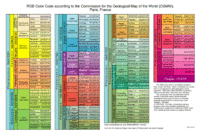The Earth is hardly the stable ground we think it is when we walk on it from home to work to school and so on. Most of it is still like it was when it formed 4.5 billion years ago, a 4,000 miles deep 5 layer ball of Fe/Ni (18,000 °F). One of first species to live upon it, the stromatolytes, still have offspring alive today. An exception to the general reality that almost all of the species that have lived on Earth are now extinct.
So to learn about most life on Earth requires using the Cosmic Calendar. But only part of it, the fall equinox to New Year’s Eve. So we must use a slightly larger time scale. Many times since then our Earth was part of catastrophes so severe, all life upon it almost came to an end. These events mark the beginning and end of the Eras of Earth.
Today we will be paleontologists, discovering 3 species in an epoch you alone will explore. Your excavations must include
- Narrow the timescale of your species to an age or stage
- Use 7 Properties of Life to organize your research
- Place your species in the Cosmic Calendar
Use to following links to help you make sense of the massive spaces of time our Earth has existed through:
NOTE: Some species have lived through multiple geologic periods of time and may still be alive today (ex: cockroaches and horses). You must describe the species as it existed in the past, not today.
NOTE: the following species have already been researched by prior classes, and cannot be chosen for this class.
No Stromatolytes or Trilobytes!
If you chose a species with a modern descendant, describe its traits back then, not as it appears today.
Cambrian
- Anomalocaris
- Brachiopods
- Hallucigenia
- Hexactinellida
- Trilobytes
Ordovician
- Arandaspis
- Conodonts
- Glomalean
- Graptolite
- Neoasaphus
- Tiktaalik
Silurian
- Coelancanthiformes
- Cooksonia
- Eurypterid
- Pneumodesmus Newmani
Devonian
- Acanthostega
- Adelophthalumus
- Attercopus
- Dicranurus
- Gogonasus
- Hyneria
- Ostracoderms
- Placoderm
- Rhyniella
- Rhyniognatha Hirsti
- Tetrapod
Carboniferous
- Arthropleura
- Colosteus
- Eryops
- Hylonomus
- Rhizodus
- Stethacanthus
- Tullimonstrum
Mississippian
- Archeothryis
- Drydenius
- Colosteus
- Eryops
- Hylonomus
- Mesolepis
Pennsylvanian
- Anthracosaur
- Arthropleura
- Edaphosaurus
- Hylonomus
- Paleodictyopterans
Permian
- Dimetrodon
- Diplocaulus
- Eryops
- Helicoprion
- Jimbacrinus
- Pareiasaur
- Raranimus
- Therapsidas
Triassic
- Clatrotitan
- Coelophysis
- Cynognathus
- Gerrothorax
- Herrerasaurus
- Huphsuchus
- Ichthyosaurus
- Lystrosaurus
- Nothosaurus
- Plesiosaur
- Prestosuchus
Jurassic
- Allosaurus
- Archaeopteryx
- Belemnitida
- Brachiosaurus
- Brontosaurus
- Camarasaurus
- Castorocauda
- Ceratosaurus
- Cryolophosaurus
- Dilophosaurus
- Diplodocus
- Glyphea
- Guanlong
- Lexovisaurus
- Megalosaurus
- Rhamphorhynchus
- Spinosaurus
- Stegosaurus
- Stenopteryguis
- Tyrannosaurus Rex
Cretaceous
- Alamosaurus
- Albertosaurus
- Ankylosaurus
- Carnotaurus
- Confuciusornis
- Dakosaurus
- Dromasaurs
- Kakuru
- Kronosaurus
- Oviraptor
- Parasaurolophus
- Platypterygius
- Pteranodon
- Pterodaustro
- Pteranodon
- Qantassaurus
- Spinosaurus
- Triceratops
- Velociraptos
Paleocene
- Chriacus
- Crodilia
- Gastornis
- Eobasileus
- Mesonychid
- Pantolambda
- Ornithorhynchiedae
Oligocene
- Archaeospheniscus
- Agriarctos
- Branisella boliviana
- Janjucetus
Eocene
- Anoplotheriidae
- Gigantophis
- Knightia
- Xiphodontidae
Miocene
- Argentavis
- Deaodon
- Hyaendon
- Livyatan
- Megalodon
Pliocene
- Chalicotherium
- Equus simplicidens
- Megatherium
Pleistocene
- Champsosaurs
- Dire wolf
- Glyptodon
- Megalonyx Jeffersonii
- sabre tooth cat
- straight tusk elephant
- woolly mammoth
- Zygomaturus

